Kesejarahan Teks pada Naskah Syair Kupu-Kupu
DOI:
https://doi.org/10.37014/jumantara.v12i1.1114Keywords:
Syair Kupu-Kupu, The History of Text, Symbolic Poetry, Carl SchoemannAbstract
Manuscript Syair Kupu-Kupu (hereinafter referred to as SKK) is one of the manuscripts that fall into the category of symbolic poetry. This manuscript stored at Staatsbibliothek zu Berlin with the Schoemann V 40 manuscript code. SKK has three version of texts. This manuscript does not have a colophon containing information about the manuscript. SKK manuscripts is included in the category of symbolic poetry because the contents of the SKK text are assumed to represent past events written using animal and plant symbols as character names. This characteristic of symbolic poetry described by GL Koster in his dissertation research. The research on the SKK manuscrips was carried out to determine the history of the emergence of symbolic poetry through the information contained in the text. The theories used in this research are codicology and textology theories. Codicological theory is used to describe the text. Textological theory is used to analyze the history of the SKK text and the reasons for the emergence of symbolic verses. The result of the research on the SKK manuscript was that the SKK manuscript was written at the request of a manuscript collector from Germany named Carl Schoemann while in the Dutch East Indies. In addition, the emergence of symbolic poetry in the Malay region is due to the concept in the Malay community to hide things that are considered taboo to be told. This is in accordance with the agreement of the first Malay king with his people in Malay History.References
Ali, As'adi. "Ulama Perintis Syair Melayu." Jurnal Islam Nusantara, (2018).
Djamaris, E. Metode Penelitian Filologi. Jakarta: CV. Manasco. 2002.
Fang, Liaw Yock. Sejarah Kesusastraan Melayu Kelasik. 2011.
Haar, B. J. ter. Ritual and Mythology of the Chinese Triads. Leiden: Brill Publisher. 1998.
Hapsari, Novia Rizki. "Pengembangan Buku Pengayaan Apresiasi Teks Fabel Bermuatan Nilai-Nilai Karakter Bagi Siswa SMP." Jurnal Pendidikan Bahasa Dan Sastra Indonesia Vol 5, no. 2 (2016):13-22.
Hidayat, Rahayu Surtiati. Hakikat Ilmu Pengetahuan Budaya. Yogyakarta: Yayasan Obor Indonesia. 2018.
Hinzler, H. I. R. Codices Manuscript: Catalogue of Balinese Manuscript. Leiden: Brill: Leiden University Press. 1986.
Ilyas, Husnul Fahimah. "Menyisik Sejarah Penulisan Manuskrip Lontaraq Suqkuna Wajo." Browsing The History of Writing Manuscript of Suqkuna Wajo Lontaraq. Al-Qalam (2011).
Klinkert, H. C. Lets over de Pantons of Minnezangen Der Meleijers. Bijdragen tot de Taal-, Land -en Volkenkunde. 1868.
Koster, G. Mengembara Di Taman-Taman Yang Menggoda. Jakarta: KITLV. 2011.
Mulyaadi, Sri Wulan Rujiati. Kodikologi Melayu Di Indonesia. Jakarta: Fakultas Sastra, Universitas Indonesia. 1994.
Novitasari, Delima. Syair Kupu-Kupu: Suntingan Teks Disertai Analisis Kodikologi Dan Tekstologi. Skripsi. Surakarta: Universitas Sebelas Maret. 2020.
Overbeck, Hans. Malay Animals and Flower Shears. Singapore: Malayan Branch, Royal Asiatic Society. 1934.
Ricklefs, M. C. Indonesian Manuscripts in Great Britain. Oxford: Oxfor University Press. 1977.
Rohmana, Jajang A. "Empat Manuskrip Alquran Di Subang Jawa Barat (Studi Kodikologi Manuskrip Alquran)." Wawasan: Jurnal Ilmiah Agama Dan Sosial Budaya (2018).
Sutopo, H. Metodologi Penelitian Kualitatif: Dasar-Dasar Dan Terapannya Dalam Penelitian. Surakarta: UNS Press. 2002.
Wilkinson, R. J. The Poetry of the Malays. Singapura: Kelly and Walsh. 1913.
Winstedt, R. O. A History of Classical Malay Literature. Kuala Lumpur, dst.: Oxford University Press. 1977.
Wirajaya, Asep Yudha. Tekstologi: Sebuah Pengantar. Magetan: Awan Pustaka. 2015.
Downloads
Additional Files
Published
Issue
Section
License
Copyright (c) 2021 Jumantara: Jurnal Manuskrip Nusantara

This work is licensed under a Creative Commons Attribution-ShareAlike 4.0 International License.
- This statement is the author's commitment to respect copyright, both in terms of citing other people's work and utilizing journal content. If necessary, the author can send an Authenticity Statement of Article stating that "this work is the author's original idea and has never been sent to another publisher and published in any publication"
- The author retains copyright.
- The moral rights of publication belong to the author.
- Formal legal aspects in the use of journal publications refer to the Creative Commons Attribution-ShareAlike 4.0 (CC BY-SA) license, which means that journal content can be used freely for any purpose.










